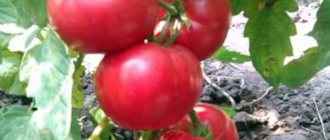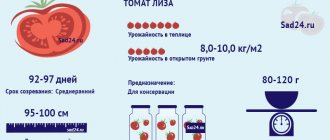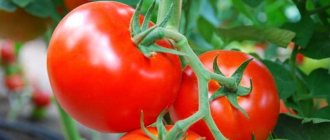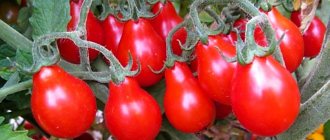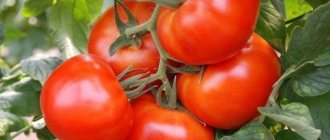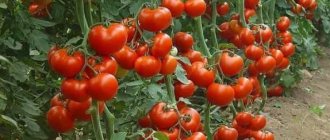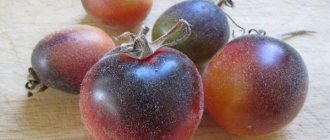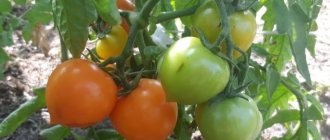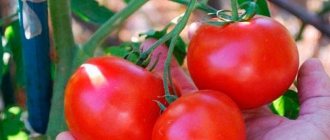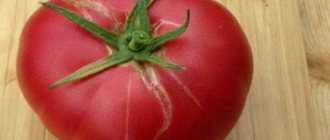Azov consistently produces high yields and is grown in open and protected beds. Recommended for salad use and mass preparations.
| Height | Landing location | Ripening time | Fruit color | Fruit size | Origin | Fruit shape |
| Tall | Greenhouse, Open ground | Mid-season | Reds | Average | Hybrid | Flat-round |
What does the plant look like?
Tomato Azov F1 was created by breeders for cultivation in film greenhouses in Russia. The plant looks like this:
- Bush with unlimited growth (indeterminate). Under suitable conditions, the stem grows up to 2 m in length.
- The tomato is endowed with short internodes.
- Leaves with edges, medium in size, there are many of them.
- Raceme inflorescences are collected from a simple type of flowers.
- The fruits turn red when ripe. Their shape is round, without ribs.
- Average weight 160 g.
- The tomato is sweet and sour in taste. The aroma is pronounced.
- In the cross section of a tomato, 4-6 chambers are visible. There are few seeds in the pulp.
According to ripening time | By type of growth | By type of use | By growing method | Fruit weight (g) | Yield (kg/m²) | Fetal characteristics |
| Mid-early (111-115 days) | Indeterminate (up to 2 m) | Universal | For film greenhouses | 110-160 | To 10 | Round, red, fleshy |
What is an Azov tomato?
Characteristics and description of the variety:
- the fruits are round in shape, smooth skin and bright red in color;
- maximum weight of 1 tomato - 160 g;
- the fruits taste sweetish and sour; ideal for preparing salads;
- 5-6 inflorescences are formed on 1 bush;
- From 1 m² up to 10 kg of crop is harvested.
Positive and negative sides
The positive qualities that breeders have invested in tomatoes are making the hybrid increasingly popular among gardeners.
Main characteristics:
- The bush is tall, that is, it bears a large number of fruits.
- With proper care, high yields are guaranteed. A bush produces up to 5 kg of tomatoes per season.
- In case of any deviations in growing conditions, the tomato sets fruit, so the plant does not require a permanent greenhouse.
- The hybrid is resistant to many diseases that affect other varieties. Learn more about tomato diseases in this article.
- Marketable appearance and excellent transport qualities make it possible to grow tomatoes for sale.
- Extended fruiting extends the harvest time.
The variety does not have any obvious shortcomings pointed out by gardeners.
Tomato care
After transplantation, each bush is tied up; this procedure is carried out in two ways:
- tying to stakes;
- garter by the stem to the crossbar.
Since the plant is not limited in growth, it will have to be tied up several times, being careful not to damage the stem.
- Pinching is an important element in obtaining a high-quality harvest. When forming into one lash, all side shoots are removed. If the foliage prevents sunlight from reaching the fruit, it is also gradually removed.
- Fertilizing is an integral part of growing any variety of tomatoes. During cultivation, plants are fertilized at least three times with organic and mineral fertilizers.
- Watering and loosening the soil is carried out as it dries. Excess moisture is just as harmful as drought, so you need to carefully monitor the level of soil and air moisture in the greenhouse.
- Weeding will help tomatoes ripen faster. Microelements will not go into the weeds and the plants will grow better.
- Timely harvesting of fruits will extend the ripening period of tomatoes.
With simple care of tomato plants, you get a good harvest of tasty fruits.
Features of agricultural technology
The tomato cannot be called whimsical, but in order to obtain a high yield, you should follow some rules.
Seeds are sown 2 months before the planned transfer of seedlings to the ground. 2.5-3 plants are planted per 1 m². This placement allows the greenhouse area to be used most efficiently. At the same time, trellises or other types of supports are placed to which long shoots will be tied.
All lateral stepsons are removed as they appear. Leave one central stem. The leaves covering the fruits are also regularly removed. As a result, the tomato is well lit and ventilated. Watering is carried out regularly. The soil should not be allowed to dry out.
Advice. It is better to equip the greenhouse with a drip irrigation system. This way, water will be supplied to the plants in a timely manner and in sufficient quantity.
Agricultural technology Varieties Azov
Tomatoes are grown in seedlings. At the end of March, at home, seeds are planted on seedlings and covered with film until the first shoots. When the seeds germinate, the film is removed, the container with the seedlings is placed in a sunny place and the sprouts are cared for.
When two permanent leaves form on the plants, they are planted in separate containers with fertilized soil. In this way, the seedlings grow before the onset of warm weather. At a constant temperature of 22 degrees, the sprouts are transplanted into a greenhouse for further growth.
Reviews from gardeners
Natalia from Samara. I grow tomatoes and cucumbers in a greenhouse located on a plot near my house. I prefer tall varieties. When tied to a trellis, they are easy to care for. I chose the tomato in question based on the photo. The result was pleasantly surprising. Most of the plants suffered from fusarium last season and had to be tinkered with. Azov held out and brought a good harvest.
Valentin from the Moscow region. There is a greenhouse in the garden at the dacha. Last season I planted this tomato there. I tied it to a trellis, formed it into one stem, and took care of it regularly. By the end of July I had a good harvest. Most of the fruits were eaten in fresh salads; the remainder was sent to the cellar in the form of juice and paste.
Svetlana from Anapa. The local climate allows you to grow tomatoes in the garden, in an open bed, but for tall tomatoes I have a small greenhouse on my site. Here we collect tomatoes before the cold weather. I took seedlings from neighbors who grow vegetables for sale. I liked the hybrid both because of its unpretentiousness and the taste of the fruit. More buckets were removed from 3 bushes.
The Azov tomato is one of those hybrids that can be recommended to beginning gardeners. An unpretentious plant will produce enough tasty fruits under any conditions.
Landing
Cultivation is carried out by seedling method. Sowing of seeds begins in the last week of February and continues in the first half of March.
How to plant correctly:
- Containers with a wall height of 10 cm (boxes, containers) are filled with earth, leaving 1 cm.
- The soil mixture is made up of garden turf, peat, compost, and is pre-disinfected.
- Make grooves 1–2 cm, distance 4 cm.
- Spread the seeds in increments of 2–3 cm.
- Cover with film and place in a warm place until germination.
After the seedlings appear, watering is carried out regularly - 2 times a week, and fed with nitrogen compounds 2 times a month. When 2-3 leaves grow, the plants dive into larger containers.
Bushes are transplanted into beds at 50–55 days (with 6–8 leaves).
Description of growing features
Tomato Katya F -1 is included in the State Register of the Russian Federation as a plant variety that can be grown in open ground. It is recommended to grow tomatoes of this variety in seedlings.
To get an early harvest, gardeners recommend sowing seeds in early March with further picking. Plants that have reached a height of 15-20 cm are suitable for planting in open ground, but this can be done when there is no risk of sudden cold snaps at night and spring frosts.
When planting a plant, the following points should be taken into account: the distance between the holes should be at least 45 cm, and the holes themselves should be quite deep.
The optimal place for germination is an area with good light, but slightly dark places are also suitable.
During the growing period, you should monitor the condition of the soil; tomatoes like regular watering and constant loosening. It will not be possible to achieve good results without regular application of potash-type fertilizers. After the formation of the first fruits, fertilizer should be applied every day.
The plant's tufts are formed into 2-3 stems. And also the tomato Katya needs pinching and tying to a support.
Main characteristics of growing
Most of the points that should be taken into account when growing have already been listed, but it is worth highlighting the main nuances that will help you avoid making mistakes when growing:
- The Katya variety requires a mandatory garter;
- You should also carry out regular pinching so that the plant forms only 2-3 stems;
- When watering, you should use only settled water, not cold water, and you should water the plant at the root;
- Loosening, weeding, and mulching should be done regularly and in a timely manner;
- The fruits should be collected as they ripen in dry, warm weather.
If tomato cultivation is carried out in a greenhouse, it should be ventilated regularly. Tomatoes, not only the Katya variety, do not tolerate temperatures above 30 degrees and humidity above 60 degrees.
II. Indeterminate varieties (unlimited growth)
These are tomatoes that will grow until they turn blue until the owner or the onset of the cold season stops them. They have great yield potential, which is more successfully realized in high greenhouses. We place approximately three bushes on 1 square. With supports such as strong trellises, open ground is not prohibited, which will be especially welcome in the southern regions.
Tomato Scarlet candles
Good for pickling, sweet. This is a patented mid-early variety (Siberian breeders distinguished themselves!). In the state register since 2007. They are characterized by a high ability to form ovaries in any conditions. From 1 sq.m you can actually get a bucket and a half. The clusters are arranged in tiers, the weight of the fruit on the lower branches reaches 120 g, on the top ones - half as much.
Very lightweight. A mid-early Siberian variety for canning whole vegetables. The fruits are elongated, reaching (maximum in our conditions) 13-14 cm in length, weighing about 120 g, and have a beautiful crimson hue. They have few seeds, are very fleshy, strong, and easy to keep. If they are picked green, they do not spoil and ripen perfectly.
The longest
A new product of Siberian selection. It begins to ripen already on the 110th (you can add a couple more) days from the sprouts appearing on the surface of the soil. Fruits have a unique length - 20 cm (specific size)! They are very elongated, with a small pear-shaped constriction in the upper part, uniformly slightly expanding downwards, with a spout. Vegetable clusters bear up to seven red fruits weighing up to 180-190 g. The product is successful in transportation, long-term storage, and pickling. Collection - at least a bucket from three plants.
High yield
The variety is productive and unpretentious. Tolerates slight shading. It ties well. Neither high nor low temperatures are scary. It succeeds in protected soil, but outdoor cultivation is not prohibited. Tomatoes begin to ripen in 106-113 days; at the same time, the plant successfully continues to grow and form clusters - up to 10 pieces per bush.
Each bears up to eight graceful fruits - cylindrical and pointed, in full ripeness - iridescent pink in color. The weight of each vegetable is 100-120 g. They contain a high percentage of sugars and dry matter. They do not burst when pickled, are good for drying, obtaining thick juice and, oddly enough in your opinion, for making tomato jam. With diligent care, the bush can bear up to a bucket of quality fruit.
Tomato Niagara
Weighty brushes
This mid-early vegetable variety has been on the state register since 2010. The bush is tall, but compact in width. It has a highly branched root system, responsive to increased nutrition and good water supply. A valuable feature of this Siberian variety is its multiple clusters, each of which bears up to 14 fruits weighing 85-115 g.
Meaty and sweet
This is one of the sweetest and meatiest products of Siberian breeders. It has been registered in the state register since 2007. The tomato is mid-season (116-118 days from the appearance of sprouts), with large foliage. The fruits resemble long, sharp peppers - they grow up to 15 cm. They are an elegant red color, the weight ranges from 120-185 g. The pulp of vegetables contains very little water and seeds. In the best case, there are up to a dozen fruits in one cluster. One bush gives 2-3 kg.
Tomato Koenigsberg
Excellent ovary
Included in the state register in 2005. The variety rightfully takes its place among the most productive Siberian varieties (up to 20 kg per square meter of land in a greenhouse). It sets perfectly even in the hot atmosphere of closed ground. Plants with a powerful bush with large leaves require increased nutrition and careful pinching.
The first ovary is formed after the growth of the 12th leaf, then inflorescences are formed every 3 leaves. Refers to varieties of medium ripening; in Siberian conditions, approximately half of the crop ripens; the rest of the fruits turn red quite well when ripened. Tomatoes in the lower clusters of vegetables weigh 300 g, and in those above - no less than 150 g. The shape is elongated, heart-shaped, smooth, and beautiful.
Vitamin and sweet
Ripe tomatoes have a golden-orange color and contain a record amount of carotene vitamins. The pulp is sweet and aromatic, like berries and fruits. The ripening period is average. The lower fruits are capable of filling up to a mass of 400-450 g, higher up the bush - 200-300 g. They are oval, often with a spout. The plants grow clusters through the leaves, each containing on average, as stated, up to 5 fruits. Productivity is high. The keeping quality is excellent. It is especially tasty when salted with gelatin.
Harvest hearts
Close internodes and a powerful trunk with dense foliage are like standard varieties, only the height is two meters. The Siberian breeding novelty produces half a bucket of fruit from one such “tree”. Ripening begins on the 115th day. Forms up to 6 beautiful clusters with 5-7 red tomatoes weighing 200-250 grams, shaped like strawberries.
Tomato Budenovka
Resistant to cracking
The variety is an improved version of Ox Heart, with a higher yield (about 9.4 kg per square), early ripening, good resistance to diseases (even to late blight) and cracking of the apical tissue of the fruit for a fleshy variety. Heart-shaped, ribbed tomatoes with excellent taste.
Record weight
The variety is a new product from a team of breeding scientists under the leadership of V.F. Gavrisha. Registered in the state register in 2015. Due to the unrealistically large fruits of vegetables, it is included in the “Russian Hero” series. The variety is not very fast in terms of ripening time (from 120 days), therefore it requires early planting of seedlings, especially careful pinching and decent feeding.
In Siberia and Central Russia it works well only in closed ground conditions, including a greenhouse. The average return from a bush is 3.6 (plus or minus) kg, the record is 7 kg. The tomatoes are flat-round, slightly ribbed, have an excellent smell and are very juicy, each weighing 400-600 g, not uncommon - 800 g. There are 2-3 tomatoes in one cluster of plants; if you leave only one tomato in it, it can pull more than 1 kg. Such “bogatyrs” are better suited for salads and distillation for juice.
Bowl of salad from one fruit
One of the best salad novelties, the yield is high. The plant bears 5-6 racemes. The fruits look very attractive due to their raspberry-pink color, large up to 500-800 g. The tomatoes are flat-round, ribbed, sweet. There is high resistance to cracking; The pulp density is average. A rare quality for large-fruited varieties: the fruits do not tend to quickly soften and spoil during storage.
According to the ripening period, the variety is classified as mid-early and mid-ripe. Perfect for preparing preparations: tomato paste, juice. This tomato variety is characterized by high yield. You can remove up to 5-6 kilograms of tomatoes from one bush.
Giant orange sweet
https://www.youtube.com/watch?v=O3D1P75Z6ig
It has plasticity, rare for a large-fruited variety, and relative unpretentiousness. Delicate sweet pulp combines with excellent keeping quality. The tomatoes are round-flat (their “ribs” stand out a little), sunny orange in color. The average weight of a tomato is 0.5 kg, but in reality there are 1 kg of fruit on the bush.
Recommendations for sowing and planting plants in open ground
It is best to sow seeds for growing seedlings in March and in a specially prepared planting container with nutrient-rich soil substrate. We are talking about a combination of ordinary soil from an open area with leaf or manure humus in equal parts.
The seeds themselves should be located at a distance of 1.5-2 cm from each other. From above, the seeds are covered with an additional layer of nutritious soil no more than 0.8 cm thick. It is recommended to additionally cover the entire container with soil and seeds with film or glass. This will allow you to maintain the required air temperature inside, as well as optimal humidity. The container itself should be in a warm place. Ventilation of seedlings must be carried out daily, removing glass or film for 30 - 40 minutes. The first shoots usually appear after 7 to 14 days. As soon as the sprouts get a little stronger, the film or glass must be removed.
The optimal air temperature is 15 degrees Celsius; two weeks after the sprouts appear, it is important to increase the temperature by another 5 degrees. Watering is carried out by spraying from a spray bottle. Sprouts require sufficient lighting and mandatory additional feeding with vermicompost or a special mineral complex at the end of the third week of development of the first sprouts. It would not be superfluous to lay a thin layer of ordinary wood ash.
Planting ready seedlings in open ground is allowed from mid-May, when the risk of night frosts becomes minimal. In this case, the plant should be about two months old, and the stems should have at least five leaves. During the planting process, the root system is watered abundantly with warm water. And the distance between tomatoes should be maintained at 50–55 cm. As the stems grow, it is important to tie them to additional support in a timely manner, which will protect against breaking branches and loss of the long-awaited harvest.
As soon as the plants are planted in open ground, the necessary watering is done at the root, and not on the leaves of the plant.
Tomato growing technology
Our technology for growing tomatoes of different varieties is as follows. On our plot we allocate 6 long rows for tomatoes (including closed soil). On three of them, representatives of the best varieties of tomatoes, proven over the years, are grown (there are also tomatoes to choose from), guaranteeing a harvest according to the declared characteristics (regardless of the “delights” of the weather), and the other three are planted with new varieties, which are “considered” this way and that in during the above time. That seems to be it.
PS To make life easier for readers and reduce the time it takes to absorb the article, instead of determining the yield of vegetables in kg per 1 square meter, it will be written below - kg “per square”.
And now I am announcing the number of tomatoes tested in growing, presented below for your viewing, which can still be called the best - 60 varieties.
PS The results were recorded in an area that: with a good warm season, corresponds to the Central Black Earth region (region), and with a bad warm season, corresponds to the North-Western region. Naturally, this range of latitudes in which the above regions are located definitely includes Siberia, the Moscow region, the Middle Zone, the Urals, the Far East, and then figure out for yourself where exactly the paths lead to your site.
